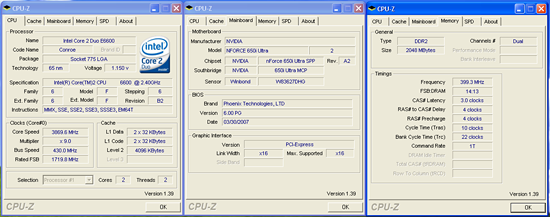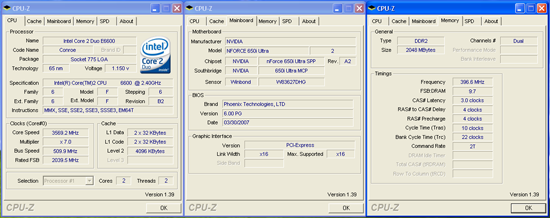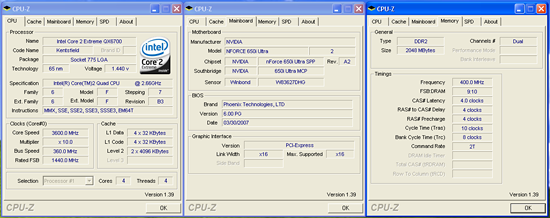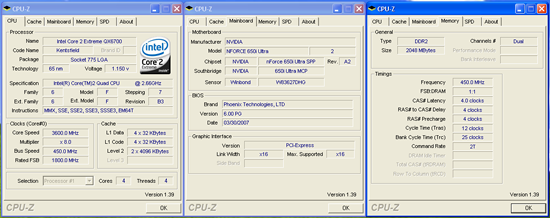EVGA nForce 650i Ultra: Performance on a Budget
by Gary Key on April 10, 2007 2:00 AM EST- Posted in
- Motherboards
Overclocking - E6600
After trying a variety of memory timings and system voltages we discovered our 9x430 FSB setting was the limit for both our board and CPU. This resulted in a final clock speed of 3869MHz at 1.4750V which is the limit for our Tuniq 120 air cooler. We did find the typical FSB hole around 416~422 FSB but did not notice the same issues we had with the 680i LT SLI having several FSB ranges that were unusable. Vdroop was acceptable but not great during overclocking with an average drop of .04V during load testing with our E6600.
We dropped the multiplier on our E6600 to seven and were able to reach the same 509 FSB level as with the E6300. We were able to enter XP at 7x512 but the board was not stable. We were able to pass all benchmarks at the 7x509 setting but feel like the board is most comfortable around 485FSB. We have been testing the board for only a week so extensive 24/7 testing at 7x509 has not been completed at this time. However, we have not had a failure at this setting in the last 72 hours.
We noticed in overclock testing that we were able to extract an 1133 memory speed at 5-5-5-18 2T timings at 2.10V with our OCZ Flex PC2-6400. This matches the 680i LT SLI speeds at slightly worse timings although performance differences were minimal. Memory performance and stability was excellent once the board was dialed in.
Overclocking - QX6700
We were extremely pleased with quad core overclocking on this board as its performance was significantly better than some of the more expensive 680i boards in our results. Our board reached a final 360FSB at the stock multiplier. We were able to POST and enter XP at 368FSB but could not complete our benchmark testing.
Our processor voltage was set to 1.450V in order to maintain system stability at 360 FSB. Our processor will normally run in the 3600MHz range at 1.4125V on the 975X and P965 boards. Vdroop was acceptable on this board with the quad core processor. We would see drops as high as .04V under load testing with the average drop being around .03V during extended game testing.
We really had to loosen up the memory timings when compared to the dual core results as there was some significant crosstalk on the board with the quad core at extended FSB settings. In fact, we could not run CAS3 and 1T command rate stable together at stock settings. Our choice was to run 4-4-3-9 1T settings at stock as performance was better than running 3-4-4-10 2T. Since our quad core results with the ASUS and MSI 650i/430 boards are very similar, we believe the 650i SPP is the limiting factor in overclocking this processor.
This was probably the biggest surprise in our testing as the board had no issues reaching a stable 450FSB, although for 24/7 operation we felt like 8x440 would probably be safer based upon the memory timings being utilized. We were able to POST and enter XP at 474FSB but could not complete any benchmark testing. Until we complete long term 24/7 testing on this board with a quad core CPU, our suggestion is to stay below 430FSB level and run slightly tighter memory timings.
| EVGA nForce 650i Ultra E6600 Overclocking Testbed |
|
| Processor: | Intel Core 2 Duo E6600 Dual Core, 2.4GHz, 4MB Unified Cache 1066FSB, 9x Multiplier |
| CPU Voltage: | 1.4750V / 1.4500 (default 1.3250V) |
| SPP Voltage: | 1.50V |
| FSB Voltage: | 1.40V |
| Cooling: | Tuniq 120 Air Cooling |
| Power Supply: | OCZ ProXStream 1000W |
| Memory: | OCZ Flex XLC PC2-6400 (2x1GB) |
| Video Cards: | 1 x MSI 8800GTX |
| Hard Drive: | Western Digital 150GB 10,000RPM SATA 16MB Buffer |
| Case: | Cooler Master CM Stacker 830 |
| Maximum CPU OC: | 430x9 (3-4-4-10 1T, 798MHz) 3869MHz (+61% CPU) |
| Maximum FSB OC: | 509x7 (3-4-4-10 2T, 793MHz) 3569MHz (+91% FSB) |
| . | |
 |
| Click to enlarge |
After trying a variety of memory timings and system voltages we discovered our 9x430 FSB setting was the limit for both our board and CPU. This resulted in a final clock speed of 3869MHz at 1.4750V which is the limit for our Tuniq 120 air cooler. We did find the typical FSB hole around 416~422 FSB but did not notice the same issues we had with the 680i LT SLI having several FSB ranges that were unusable. Vdroop was acceptable but not great during overclocking with an average drop of .04V during load testing with our E6600.
 |
| Click to enlarge |
We dropped the multiplier on our E6600 to seven and were able to reach the same 509 FSB level as with the E6300. We were able to enter XP at 7x512 but the board was not stable. We were able to pass all benchmarks at the 7x509 setting but feel like the board is most comfortable around 485FSB. We have been testing the board for only a week so extensive 24/7 testing at 7x509 has not been completed at this time. However, we have not had a failure at this setting in the last 72 hours.
We noticed in overclock testing that we were able to extract an 1133 memory speed at 5-5-5-18 2T timings at 2.10V with our OCZ Flex PC2-6400. This matches the 680i LT SLI speeds at slightly worse timings although performance differences were minimal. Memory performance and stability was excellent once the board was dialed in.
Overclocking - QX6700
| EVGA nForce 650i Ultra QX6700 Overclocking Testbed |
|
| Processor: | Intel Core 2 Extreme QX6700 Quad Core, 2.66GHz, 8MB Unified Cache 1066FSB, 10x Multiplier |
| CPU Voltage: | 1.4500V / 1.4750V (default 1.3500V) |
| SPP Voltage: | 1.50V |
| FSB Voltage: | 1.40V |
| Cooling: | Tuniq 120 Air Cooling |
| Power Supply: | OCZ ProXStream 1000W |
| Memory: | OCZ Flex XLC PC2-6400 (2x1GB) |
| Video Cards: | 1 x MSI 8800GTX |
| Hard Drive: | Western Digital 150GB 10,000RPM SATA 16MB Buffer |
| Case: | Cooler Master CM Stacker 830 |
| Maximum OC: | 360x10 (4-4-4-10 2T, 800MHz, Linked) 3600MHz (+35%) |
| Maximum FSB OC: | 450x8 (4-4-4-12 2T, 900MHz, Sync) 3600MHz (+69% FSB) |
| . | |
 |
| Click to enlarge |
We were extremely pleased with quad core overclocking on this board as its performance was significantly better than some of the more expensive 680i boards in our results. Our board reached a final 360FSB at the stock multiplier. We were able to POST and enter XP at 368FSB but could not complete our benchmark testing.
Our processor voltage was set to 1.450V in order to maintain system stability at 360 FSB. Our processor will normally run in the 3600MHz range at 1.4125V on the 975X and P965 boards. Vdroop was acceptable on this board with the quad core processor. We would see drops as high as .04V under load testing with the average drop being around .03V during extended game testing.
We really had to loosen up the memory timings when compared to the dual core results as there was some significant crosstalk on the board with the quad core at extended FSB settings. In fact, we could not run CAS3 and 1T command rate stable together at stock settings. Our choice was to run 4-4-3-9 1T settings at stock as performance was better than running 3-4-4-10 2T. Since our quad core results with the ASUS and MSI 650i/430 boards are very similar, we believe the 650i SPP is the limiting factor in overclocking this processor.
 |
| Click to enlarge |
This was probably the biggest surprise in our testing as the board had no issues reaching a stable 450FSB, although for 24/7 operation we felt like 8x440 would probably be safer based upon the memory timings being utilized. We were able to POST and enter XP at 474FSB but could not complete any benchmark testing. Until we complete long term 24/7 testing on this board with a quad core CPU, our suggestion is to stay below 430FSB level and run slightly tighter memory timings.










18 Comments
View All Comments
kentster2 - Wednesday, April 18, 2007 - link
This motherboard sounds perfect for me but I can't find it anywhere. In fact I can't find any boards based on the 650i Ultra chipset available anywhere. I did find the specs on an MSI board based on this chipset but again no availability. Does anyone know when the general availability will be for these boards?yyrkoon - Thursday, April 12, 2007 - link
Still does not compare to the best AM2 'budget' board out there. Add the following, and it would do good I think:1) Heatpipe cooled chipset
2) Either one more PATA port, or 2 more SATA ports for a total of 8 drives
3) Firewire ( not supported ?! )
4) Overclocking options out the wazzu, with memeory voltages capable of 3.0v
Are the PATA ports controlled by the 430MCP ? It seems that way, going by the features list. If this is the case, WHY leave out a PATA port ? It does not make sense. These four things I've mentioned above are not too much to ask, ABIT has already proven that with the NF-M2 nView, and places like newegg, ZZF, etc can not seem to keep these boards in stock ! What gives . . .
kmmatney - Wednesday, April 11, 2007 - link
it;s obvious that having a high priced sound card will help out with frame rates, but what about a cheaper card? Would a $27 Creative Audigy SE provide the same speed benefits by taking the load from the cpu?Gary Key - Wednesday, April 11, 2007 - link
The SE will provide frame rates that are on average about 2~3% worse than the X-FI in my experiences.lopri - Tuesday, April 10, 2007 - link
Gary's measure is remarkably similar to my observations on EVGA 680i board. (Interesting because the chips used on the 680i SLI are different from 650i Ultra) Without active cooling, I saw SPP temp rising to 100C(!) and MCP to 80C. This will not only cause instability (especially mated with other high-end components) but likely shorten the lifespan of the board. Even more worrisome is that the ever-increasing popularity of those L-shaped HSFs. These HSFs provide practically zero air-flow on the board's hot (i mean, HOT) spots and therefore the heat keeps building up.
I think NV at this point just assume that their target audience are *enthusiasts* in that:
1. Enthusiasts today just accept that a new motherboard/chipset is basically a beta product and expect fix/patches via BIOS updates and/or hardware revision.
2. Enthusiasts tend to employ their own cooling solution anyway.
And that's exactly what I've done up to this date. Every single NV chipset board I bought the first thing I did was replacing stock chipset/VRM cooling with aftermarket stuff.
And I'M TIRED OF IT.
This board may be selling for $99, but in order for you to build your main rig with a peace of mind on it, you will need an aftermarket cooling for the missing SB HSF (how dare they leave it wide open like that is beyond me) and the paltry NB heatsink for a heavier one. There goes extra $20~30 quite easily.
To my eyes, this board cut so many corners and definitely not worth $99. $70~80 maybe. And I do think that's how much it'll sell for in less than a month.
nullpointerus - Wednesday, April 11, 2007 - link
When it's included, active cooling's crap anyway. The little NB/SB fans last a few months at most before giving out completely. Motherboard makers should get in touch with Zalman or somebody like them and get some decent quality HSF's on these boards.jay401 - Wednesday, April 11, 2007 - link
Totally agree! It would be stupid to buy a motherboard that requires you buy other items just to ensure stable operation and longevity.Scarceas - Tuesday, April 10, 2007 - link
Really, who needs 2.2V? If you have RAM that needs that much voltage, chances are you paid more money for it, and the board you are looking to use it with will probably not be a budget board.WT - Tuesday, April 10, 2007 - link
I have an eVGA N41 board, so I want to like this thing, but looking at this 650 board .. blechhh .. talk about plain Jane !! It looks like a straight reference board or an Intel board ! Regardless of looks, performance is what we want, so I would refer anyone looking at this board to read Anand's earlier article on the MSI P6N Platinum and see if that isn't a better fit for your needs. The extra $40-50 is well justified (in my case at least) with the better cooling setup on the MSI board as well as Firewire (just bought a miniDV camcorder) so give that a read as well.If the MSI Plat is priced too high, then check out the FI board priced at $108 at popular vendors websites.
Pirks - Tuesday, April 10, 2007 - link
Gary, E6300 has TWO megabytes of cache, not FOUR